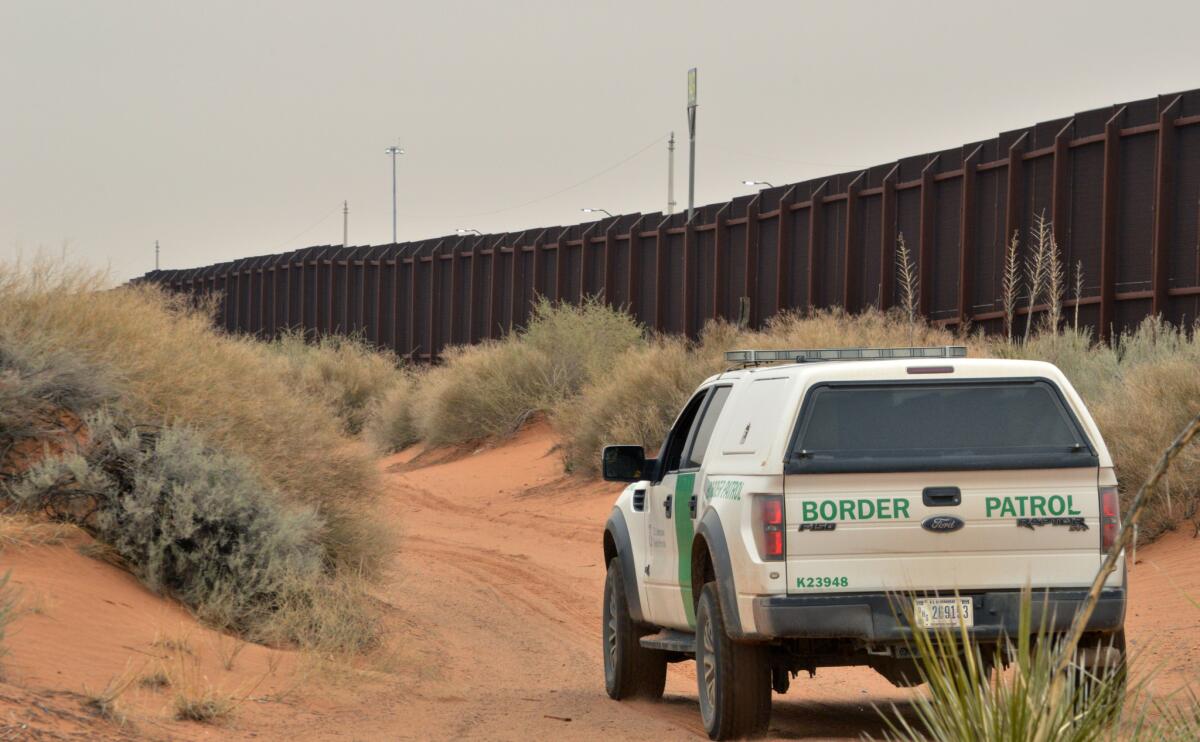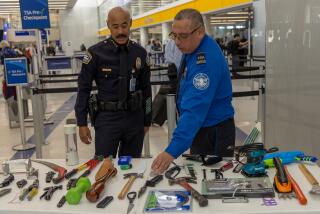Border Patrol reports using force less frequently, but critics don’t have much faith in data

A Border Patrol agent drives near the U.S.-Mexico border fence in Santa Teresa, N.M.
Border Patrol agents and customs officers have used force less frequently this year as they face fewer assaults, with just seven uses of firearms in the first five months of the fiscal year, according to figures released Thursday.
But the official tally omitted at least one fatal shooting in El Paso, calling into question its accuracy and highlighting the need for more detailed reporting, civil rights advocates said.
“It speaks to a lack of confidence in the statistics themselves. I don’t think there are that many firearm incidents that you can’t have a tabulation of what happened,” said Chris Rickerd, policy counsel with the American Civil Liberties Union in Washington, adding that until more detailed numbers are released, “it’s very hard to have faith in these statistics.”
He said critics have long demanded more transparency and accountability from U.S. Customs and Border Protection. “For the largest law enforcement agency in the country, these are vital things.”
The agency reported 28 uses of force involving firearms last fiscal year, 29 the year before.
For the first time on Thursday, the agency broke down use-of-force figures by geographic sector for Border Patrol, although two other agencies within CBP responsible for three gun and 18 less lethal incidents -- the Office of Field Operations and Air and Marine Operations -- were not included in the breakdown.
The breakdown of the other four incidents showed that the Border Patrol’s use of firearms during the first five months of the fiscal year starting in October was spread among the Rio Grande Valley, San Diego and Tucson sectors.
On Feb. 4, three Border Patrol agents on patrol in downtown El Paso heard gunshots, found someone fatally wounded on the ground, and pursued a man fleeing on foot, according to a Border Patrol statement. When the man pointed a gun at a passing driver, then at one of the agents, an agent shot the man, who later died.
Only one agent opened fire during the incident, which would mean one use-of-force report. But no uses of force involving firearms were reported for El Paso sector in 2016.
After The Times contacted the agency, spokesman Carlos Diaz said an error in merging databases had resulted in the omission. He said the total would be updated Thursday to eight firearm uses of force.
In the San Diego sector, a Border Patrol agent fired Nov. 15 at a suspected human smuggler, or “coyote,” caught with a group of 14 immigrants who had hurled a softball-size rock at the agent and fled near Jacumba, Calif., according to a statement released at the time.
The suspect, Martel Valencia-Cortez, 39, turned himself in last month and was take into federal custody on an outstanding warrant for human smuggling.
In the Tucson sector, a suspect who assaulted a Border Patrol agent and fled from a truck carrying more than a ton of marijuana was shot and wounded by the agent Jan. 25 near the New Mexico border, according to an agency statement. The agent suffered minor injuries.
In the Rio Grande Valley sector, two agents on patrol near the Rio Grande river spotted four men attempting to cross on a raft from Mexico, heard gunshots, and one of the agents returned fire in Fronton, Texas, on Jan. 11. No injuries were reported, according to an agency statement.
The new numbers show a decrease in the use of what Border Patrol calls “less lethal” weapons such as pepper-ball guns and Tasers. There were 185 uses of less lethal force during the first five months of the year compared to 756 in all of last fiscal year, 1,008 the year before.
Less lethal force was concentrated in several sectors: the Imperial Valley’s El Centro (59), Tucson (30), El Paso (21), Rio Grande Valley (19), San Diego (17) and Laredo (16).
The reason for the overall decrease in use of force was unclear, although agents face an ongoing surge in families and children crossing the border illegally and are seeing fewer assaults.
Some of the sectors that saw the most use of force also saw the most apprehensions during the same period. Texas’s Rio Grande Valley has been the epicenter of child and family migration for the last few years and saw the most total apprehensions during the first five months of the year: 80,452, followed by Tucson (33,931), Laredo (17,945), San Diego (14,449), Del Rio (11,189) and El Paso (10,208).
Assaults on border officers and agents decreased so far this year for the first time in several years, down to 176 compared to 390 all of last year and 373 the year before.
The numbers were released ahead of the busy summer season, when illegal migration usually increases.
It was not clear from the government figures how many of the uses of force resulted in deaths.
A half-dozen people were killed in altercations with Border Patrol agents along the U.S. border last calendar year, four the year before, according to a tally kept by the ACLU’s Regional Center for Border Rights, based in Las Cruces, N.M.
U.S. Customs and Border Protection has been under pressure to reverse what its own experts consider a pattern of excessive force by agents.
New guidelines on weapons were announced last year, and officials have pointed to reductions in the use of force as evidence that agents are using better judgment in the field.
R. Gil Kerlikowske, the head of U.S. Customs and Border Protection, announced new training and guidelines last year to reduce abuses and changes in how use of force is investigated.
“CBP has implemented and continues to implement significant policy, procedural, training and programmatic reforms that have equipped CBP law enforcement personnel to carry out their duties more safely and effectively,” the agency said in a statement that accompanied the new figures. “Reforms have also improved CBP’s ability to investigate and review use of force incidents to determine whether the application of force is consistent with the law and policy.”
But Rickerd of the ACLU noted, “There is no analysis provided on how de-escalation training is having an effect on whether force is used.”
Three years ago, a group of police experts reviewed 67 deadly force cases and issued a report criticizing Border Patrol use-of-force guidelines that granted agents more leeway than other law enforcement agencies.
Rickerd said the agency should follow Department of Justice guidelines and release more detailed use of force reports, including how many times a year agents pointed a firearm, used physical force beyond handcuffing, fired a Taser or struck someone with a baton. So far, U.S. Customs and Border Protection officials have refused.
On Thursday, the agency released an official request for information about body cameras, which could lead to the devices being issued to agents. Kerlikowske had said there were no plans to immediately issue body cameras back in November after the release of an internal report that found cameras the agency had tested were impractical.
Advocates have been demanding body cameras be required for years, Rickerd said, and while Thursday’s announcement was a good sign, he said it has taken “far too long.”
“The urgency with which this is needed given CBP’s track record on use of force is not being matched with deployment” of the cameras, he said.
molly.hennessy-fiske@latimes.com
Twitter: @mollyhf
ALSO
Here’s who Donald Trump is taking foreign policy advice from
‘A dire prediction’ on melting ice sheets and rising sea levels
Former House Speaker Dennis Hastert accused of sexual abuse by at least 4, sources say
More to Read
Start your day right
Sign up for Essential California for news, features and recommendations from the L.A. Times and beyond in your inbox six days a week.
You may occasionally receive promotional content from the Los Angeles Times.







